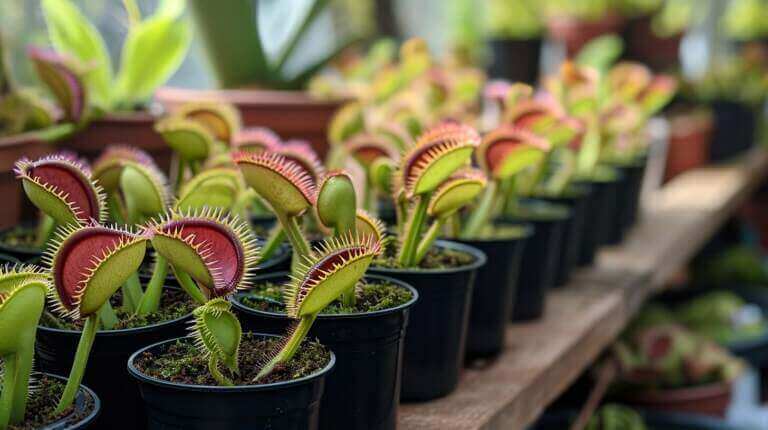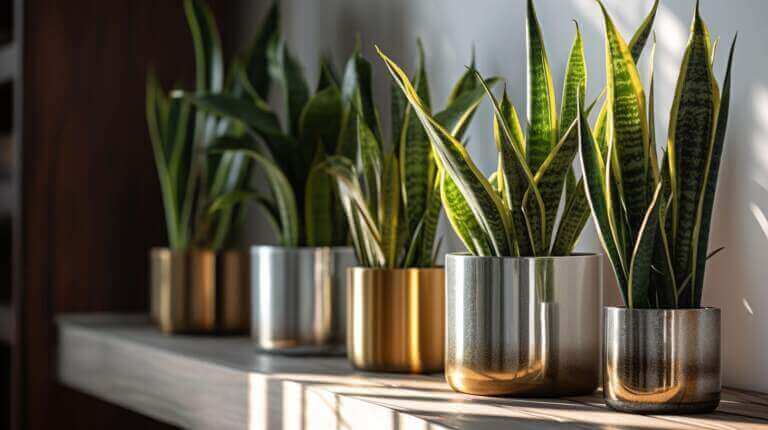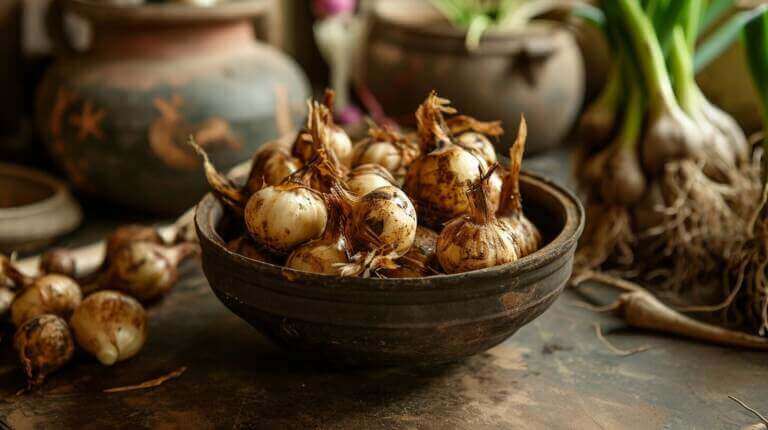When to Repot Dracaena Houseplants? Choosing the Right Pot & Soil to Repot a Dracaena
Knowing when to repot your Dracaena indoor houseplant is crucial for its overall health and growth. Repotting allows the plant to have adequate space for its roots to grow and access essential nutrients. It also helps prevent the plant from becoming rootbound, which can hinder its development and lead to poor health.
Dracaenas should typically be repotted every 3 to 5 years or when they start showing signs of being rootbound. These signs include roots circling around the pot, emerging from drainage holes, or pushing the plant up and out of its container. Repotting at the right time ensures that the plant has enough room to thrive and continue to beautify your home.
The best time to repot your Dracaena houseplant is during the early fall, spring, or summer months. These seasons are ideal because the plant is actively growing at this time, which promotes faster root establishment in the new pot.
Key Takeaways:
- Repotting Dracaena houseplants is important for their overall health and growth.
- Repot every 3 to 5 years or when signs of being rootbound appear.
- Best times to repot are during the early fall, spring, or summer months.
- Ensure the plant is well-watered a day or two before repotting.
- Use a pot one size larger than the original and with drainage holes.
Signs That Your Dracaena Houseplant Needs Repotting
There are several signs to look out for that indicate your Dracaena houseplant is ready to be repotted. One of the most obvious signs is when the roots start to become visible at the surface of the soil. This indicates that the plant has outgrown its current pot and needs more space to grow. Additionally, if you notice that water is quickly running through the pot without being absorbed by the soil, it may be a sign that the roots have become compacted and the plant is no longer able to take up water efficiently.
Another sign to watch for is stunted growth or a lack of new growth. If your Dracaena houseplant isn’t producing new leaves or if the existing leaves are smaller than usual, it may be a sign that the plant is rootbound and needs to be repotted. Additionally, if you notice that the plant is becoming top-heavy and leaning to one side, it may be an indication that the roots are overcrowded and the plant needs a larger pot to provide stability.
In some cases, your Dracaena houseplant may show signs of distress such as yellowing leaves, wilting, or root rot. These symptoms can occur when the roots are suffocating due to overcrowding or poor drainage. Repotting the plant in new potting soil and use a larger pot can help improve the health of the roots and prevent further damage.
| Signs Your Dracaena Houseplant Needs Repotting |
|---|
| Visible roots at the surface of the soil |
| Water quickly running through the pot without being absorbed |
| Stunted growth or lack of new growth |
| Top-heavy plant leaning to one side |
| Yellowing leaves, wilting, or root rot |
Remember that Dracaena houseplants should be repotted every 3 to 5 years or when these signs are evident. Repotting is a crucial step in ensuring the health and vitality of your plant, so be sure to pay attention to these indicators and give your Dracaena the space it needs to thrive.
Best Times to Repot Dracaena Houseplants
Repotting your Dracaena houseplant is most successful when done during specific times of the year. The ideal seasons for repotting are the early fall, spring, or summer months. These periods provide optimal conditions for your plant’s growth and recovery after being transplanted.
Before beginning the repotting process, it’s important to prepare your plant properly. Water your Dracaena houseplant a day or two in advance to ensure it is hydrated and ready for the transition. This will help prevent additional stress on the plant during the repotting process.
When selecting a new pot for your Dracaena, choose one that is approximately one size larger than the current pot. It’s crucial to ensure the new pot has drainage holes to allow excess water to escape and prevent root rot. Using compost-based or well-draining potting soil will provide the nutrients and proper moisture levels necessary for your Dracaena’s health.
Remember to handle your Dracaena houseplant gently during the repotting process and take caution not to damage the roots. Healthy roots are essential for the plant’s overall well-being.
Once you have prepared the new pot and soil, it’s time to repot your Dracaena. Fill the new pot about one-third full with soil and water it until there is visible water draining from the bottom of the pot. This will help settle the soil and create a moist environment for the roots. Carefully remove the plant from its original pot, gently untangle and prune any overgrown or damaged roots, and place it in the middle of the new pot. Cover with soil around the roots, making sure not to bury the plant too deep, and gently pack the soil to provide stability. Finally, water the plant thoroughly and allow any excess water to drain.
After repotting, it’s essential to maintain proper care for your Dracaena houseplant. Avoid overwatering or underwatering the plant, as these extremes can lead to stress and health issues. Place your repotted Dracaena in a location with bright, indirect light, as direct sunlight can scorch its leaves. Regularly monitor the moisture levels of the soil and water accordingly.
| Best Times to Repot | Preparation | Repotting Process | Post-Repotting Care |
|---|---|---|---|
| Early fall, spring, or summer | Water plant in advance | Fill new pot and water it | Avoid overwatering or underwatering |
| Select a pot one size larger | Remove plant from original pot | Provide bright, indirect light | |
| Use compost-based or well-draining soil | Untangle and prune roots if necessary | Monitor soil moisture levels |
How to Repot a Dracaena Houseplant
Repotting a Dracaena houseplant can be done following these simple steps. Knowing when to repot your Dracaena is crucial for its well-being and growth. Typically, large Dracaenas need repotting every 3 to 5 years or when they display signs of being rootbound. For smaller plants, consider repotting every 2 to 3. The best time to repot is during the early fall, spring, or summer months when the plant is actively growing.
Before repotting, it’s important to prepare the necessary supplies. You will need a new pot that is one size larger than the current one, ensuring it has drainage holes to prevent overwatering. Additionally, choose a compost-based or well-draining gardening soil that will provide the necessary nutrients and water retention for the plant.
Once you have gathered your supplies, start by watering the plant a day or two in advance. This will help loosen the soil and make it easier to remove the plant from its current pot. Begin the repotting process by filling the new pot about one-third full with soil to the bottom, then add a layer of soil around the root ball, top of the soil and watering it to ensure the soil is moist.
“To repot a Dracaena houseplant, gently remove the plant from its original pot, taking care not to damage the roots. If the roots are intertwined or overcrowded, you can carefully untangle and prune them to encourage better growth. Place the plant in the center of the new pot and cover the roots with soil, gently packing it in. Water the plant again, but avoid overwatering or underwatering.”
After repotting, it’s essential to provide the Dracaena houseplant with the right conditions for its continued health. Place the plant in an area with bright, indirect light, as direct sunlight can scorch the leaves. Additionally, be mindful of watering the plant, ensuring the soil is consistently moist but not waterlogged. Regularly check the moisture level by testing the soil with your finger, and adjust the watering frequency accordingly.
Choosing the Right Pot and Soil for Repotting Dracaena Houseplants
Selecting the right pot and soil is essential for the successful repotting of your Dracaena houseplant. When it comes to choosing a new pot, opt for one that is slightly larger than the current pot, allowing your plant’s roots to have room to grow. It’s important to choose a pot with drainage holes to prevent water from sitting at the bottom, which can lead to root rot.
As for the soil, using the right potting mix is crucial. Dracaenas prefer a well-draining soil mix that allows excess water to flow out easily. A good option is a compost-based soil mix, as it helps retain moisture while also providing necessary nutrients for your plant’s growth. Another alternative is a well-draining gardening soil mixed with perlite or vermiculite to improve drainage. This ensures that the roots won’t sit in soggy soil, preventing the risk of root rot.
When repotting your Dracaena houseplant, it’s important to follow a few steps to ensure the process goes smoothly. Begin by filling the new pot about one-third full with your chosen soil mix. This provides a sufficient base for your plant. Next, water the soil lightly to dampen it before transferring your plant. This helps the soil settle and prevents it from drying out your plant’s roots. Carefully remove your Dracaena from its current pot, gently untangling and pruning the roots if necessary. Place your plant in the center of the new pot and cover the roots with the remaining soil, packing it in gently. Once everything is in place, water the plant thoroughly to settle the soil and hydrate the roots.
| Pot Selection Tips | Soil Selection Tips |
|---|---|
|
|
Repotting Process
- Begin by selecting a new pot that is one or two sizes larger than the current pot. Ensure the new pot has drainage holes to prevent waterlogging.
- Prepare the new pot by filling it with a layer of fresh soil mix, about one-third full.
- Gently remove the Dracaena Marginata from its current pot, being careful not to damage the roots.
- Inspect the roots and remove any dead or damaged ones, trimming them with clean pruning shears.
- Place the plant in the center of the new pot and add more soil mix around the roots, gently packing it in. Leave some space at the top for watering.
- Water the newly repotted plant thoroughly, allowing the water to drain through the drainage holes.
Aftercare Tips
After repotting your Dracaena Marginata indoor plants, it’s important to provide proper care to ensure its health and continued growth. Place the plant in a location with bright, indirect light as direct sunlight can scorch the leaves. Avoid overwatering by allowing the top inch of soil to dry out before watering again. Regularly check the moisture level in the soil by inserting your finger about an inch deep. If the soil feels dry, it’s time to water the plant. Additionally, fertilize the Dracaena Marginata with a balanced liquid fertilizer every 2-3 months during the growing season to provide essential nutrients.
| Key Takeaways: |
|---|
| – Repot Dracaena Marginata every 2-3 years or when rootbound |
| – Use a well-draining soil mix that is slightly acidic |
| – Select a pot one or two sizes larger than the current pot with drainage holes |
| – Trim damaged or dead roots before repotting |
| – Provide bright, indirect light and avoid overwatering |
| – Fertilize regularly during the growing season |
FAQ
When should I repot my Dracaena houseplant?
Consider repotting Dracaena plants every 3 to 5 years or when they show signs of being rootbound.
What are the signs that my Dracaena houseplant needs repotting?
Signs that indicate your Dracaena houseplant needs repotting include roots circling the pot also known as root bound, roots coming out of the drainage holes, slow growth, and the plant toppling over.
What are the best times to repot my Dracaena houseplant?
The best times to repot your Dracaena houseplant are during the early fall, spring, or summer months.
How do I repot a Dracaena houseplant?
Before repotting, water the plant a day or two in advance. Use a pot that is one size larger than the original, and make sure it has drainage holes. Fill the new pot about 1/3 full with soil and water it. Remove the plant from the original pot, untangle and prune to loosen the root ball if necessary, and place it in the new pot’s middle. Cover the roots with good drainage soil rich in organic matter, pack it in, then proceed to fill the top of the root ball with fresh potting and water until you see water coming out of the bottom of the new pot.
What should I consider when choosing a pot and soil for repotting my Dracaena houseplant?
Choose a pot that is one or two sizes larger than the current pot and has proper drainage. Use compost-based or well-draining gardening soil for repotting.
How do I repot a Dracaena Marginata plant?
Repotting a Dracaena Marginata plant is similar to repotting other Dracaena species. Use a soil mix that is loose, well-draining, and slightly acidic. Repotting can be done in early spring and requires tools like a new pot and soil mix.
How do I repot a Dracaena Reflexa plant?
Repotting a Dracaena Reflexa plant is similar to repotting other Dracaena species. Use a pot and soil mix suitable for Dracaena houseplants and follow the steps outlined in the repotting process.
How do I maintain a healthy Dracaena houseplant after repotting?
After repotting, water the plant appropriately, provide it with bright, indirect light, and avoid overwatering or underwatering. Additionally, consider fertilizing, pruning, and providing a fresh soil mix to promote healthy growth.







